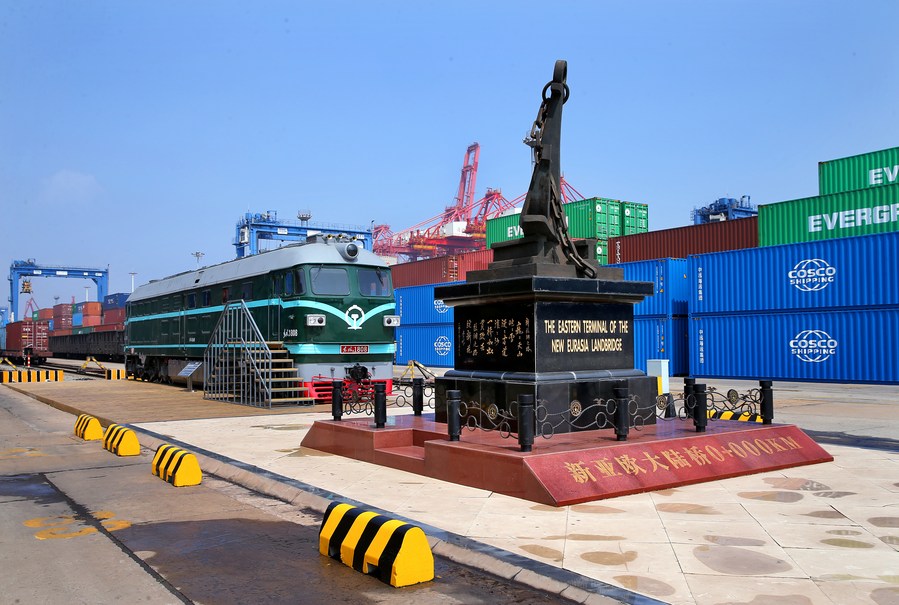China ready to elevate BRI economic, trade cooperation to new level: official

This photo taken on June 7, 2017 shows the eastern terminal of the new Eurasia landbridge in Lianyungang, east China's Jiangsu Province. (Photo by Wang Jianmin/Xinhua)
BEIJING, Oct. 11 (Xinhua) -- Ten years after the Belt and Road Initiative (BRI) was launched, China will continue to work with participating countries, aiming to take economic and trade cooperation to a new level, a Chinese official said.
In an interview with Xinhua, Vice Commerce Minister Guo Tingting said BRI cooperation has delivered mutual benefits over the past decade, featuring deepened trade and investment cooperation, more abundant connectivity projects, and improved cooperation mechanisms.
"China's super-large market has provided important development opportunities for BRI participating countries, which contributed nearly half of China's total imports," Guo said.
As the major trading partner of over 110 BRI countries, China saw its total goods trade with all BRI countries reach close to 2.9 trillion U.S. dollars in 2022. China's direct investment in BRI partner countries topped 30 billion dollars last year, while BRI countries invested more than 20 billion dollars in China.
This strengthened cooperation has promoted the integration of industrial and supply chains and delivered more momentum to the construction of an open world economy, Guo said.
In terms of project cooperation, the past ten years witnessed an array of projects that have genuinely improved people's lives, including the China-Laos Railway, the Africa Centres for Disease Control and Prevention headquarters, and the introduction of agricultural technologies such as Juncao and hybrid rice to BRI countries.
"These cooperation projects have helped BRI countries improve infrastructure construction, promote connectivity, enhance people's well-being, and strengthen their development capacity," Guo said.
Demonstrating the efficiency of project construction, the actual turnover of Chinese contractors in BRI countries topped 100 billion U.S. dollars each year over the past decade.
Cooperation platforms and mechanisms have also been improved, Guo said. China has signed free trade agreements with 20 BRI countries, with the implementation of the Regional Comprehensive Economic Partnership (RCEP) agreement creating the world's largest free trade area.
A total of 47 memorandums of investment and cooperation in green, digital and marine sectors were inked between China and BRI countries, and the number of countries participating in Silk Road e-commerce cooperation grew to 30.
A series of exhibitions, including the China International Import Expo and the China International Fair for Trade in Services, helped support businesses in seizing BRI opportunities.
BUILDING INFRASTRUCTURE
Infrastructure construction is crucial to BRI cooperation. Guo said China's construction contracts with BRI countries reached 2 trillion U.S. dollars in the past decade, and the actual turnover of Chinese contractors stood at 1.3 trillion dollars.
These projects covered a wide range of areas from transport to power and water conservancy, featured green development and emerging sectors, and helped improve people's lives, Guo said, citing some landmark projects including the China-Laos Railway, the Jakarta-Bandung High-Speed Railway, and the Mombasa-Nairobi Standard Gauge Railway.
China also carried out more than 1,600 foreign aid projects in BRI countries, in the fields of education, health, environmental protection, and poverty reduction.
Looking forward, Guo said more efforts will be made to build more high-quality projects, improve infrastructure connectivity, encourage the integrated development of investment, construction and operation, and guide businesses to expand green and new-type infrastructure cooperation.
DEEPENING TRADE COOPERATION
China has signed free trade agreements (FTAs) with 28 countries and regions, including 20 BRI countries, Guo said.
In the past ten years, China signed bilateral FTAs with the Republic of Korea, Georgia, Ecuador and Nicaragua, and upgraded FTA agreements with ASEAN, Chile and New Zealand. The RCEP agreement signed in Nov. 2020 took effect in June this year for all 15 members.
China will continue to expand the high-standard free trade area network, work actively towards joining the Comprehensive and Progressive Agreement for Trans-Pacific Partnership and the Digital Economy Partnership Agreement, and push forward negotiations on more FTAs or agreement upgrades, Guo said.

